Abstract
Herbal cosmetics are deeply rooted in ancient practices to enhance beauty and minimize skin problems like acne, pigmentation, dryness, wrinkles and anti-aging effects etc. These products offer a spectrum of physiological benefits, including anti-acne, brightening, anti-inflammatory, moisturizing, antioxidant and anti-aging properties, all while minimizing adverse reactions. Herbal formulations have gained widespread global appeal. Time-tested Indian herbs like Turmeric, Fenugreek, saffron; Neem, sandalwood, etc. have been integral part of skincare rituals for centuries. Fenugreek is known for its anti-aging properties and is used to reduce blemishes and dark circles. Neem is known for its anti-fungal characteristics and aid in the lightning of acne scars. Saffron is used for skin brightening and skin moisturizing. Turmeric is used as an anti-inflammatory and antioxidant. In this research, multiple herbs are used for the formulation of peel-off mask. In this article we study about anti-aging property of fenugreek peel off mask.
Keywords
Multi herb Peel of mask, Fenugreek, saffron, Neem, Anti-acne, anti-aging.
Introduction
The skin is a layer or tissue that covers and protects the body from external hazards (Grace et al., 2015). As we get older, the skin will experience an aging process. It is caused by various factors from within and outside the body. Factors from outside the body, such as exposure to sunlight, can cause skin damage. The process of damaging the skin will appear dull and wrinkled, the skin will age faster, and black spots will appear. Exposure to sunlight comes from ultra violet (UV) rays and ultra violet is a components that contributes to various diseases of skin [1]. Peel-off mask have been developed especially for cosmetic treatment which is used in beauty salon. Peel-off mask mask is applied directly on the skin because the formulation is in ready to use form. When it applied on skin and it slowly hardens, moisture collects in the horny layer under the elastic mask film, through which air and water is not allowed to permeate. At the same time on other the hand, the main active substances and other active substances of the formulation, are able to penetrate well into the skin and intensively supply the substances within a short space of time[2].
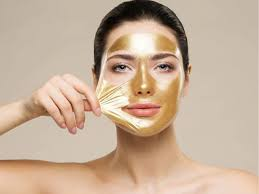
Figure 1: Peel Off Mask
A peel-off mask is typically preparation that spread over the face as a thin layer using the fingers or spatula. Once it completely dried, the liquid film peels off from the face, leaving behind a thin, plasticized film without any residue. It effectively deep cleans pores, removes skin impurities, and tightens, rejuvenates, and heals facial skin. Additionally, peel-off masks may provide slight moisturization while enhancing the occlusive effect, which promotes increased blood flow, activates skin cells, and facilitates impurity removal. Acne is a prevalent and persistent inflammatory skin issue that targets the sebaceous glands. It commonly arises during adolescence and troubles individuals aged 12 to 25. According to the Global Burden of Disease report, around 85% of teenagers and young adults encounter acne vulgaris. Acne frequently originates from bacterial presence on the skin's surface, with Propionibacterium acnes and Staphylococcus epidermidis being prevalent microbes found in acne lesions.[3]
1.1 Benefits of Applying Face Mask: [4,5,6,7]
1. It nourishes the skin.
2. It helps to reduce acne, and black heads depending on its herbal ingredients.
3. Face masks usually remove dead cells of skin.
4. These face masks provide a soothing and relaxing effect on skin.
5. They help to restore the lost shine and glow of skin in short span of time.
1.2 Aging Property of Peel off mask (Fenugreek):-
Fenugreek powder can help repair damaged cells and regenerate new cells, which can reduce the appearance of wrinkles, fine lines, and age spots.
Treats oily skin
Fenugreek powder face masks can reduce oiliness and treat acne and other skin problems.
Hydration
Fenugreek has moisturizing properties that can help with dry and flaky skin.
Skin radiance
Fenugreek can improve skin radiance through antioxidant protection, brightening properties, and hydration.
Soothes skin
Fenugreek seeds can soothe skin and mucous membranes, and relieve skin irritation and swelling. Fenugreek can be used in combination with other natural ingredients like neem, saffron, and turmeric in peel-off masks. The effectiveness of these masks depends on factors like skin type, sensitivity, skincare, concern
1.3 Anatomy of skin
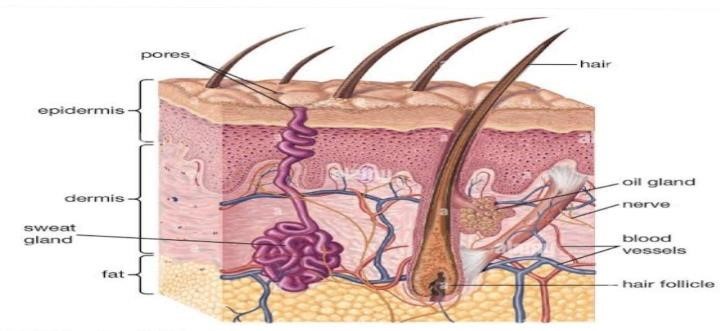
Figure 2: Longitudinal section of skin
Skin is the largest part in the body. It consists of three layers. The outer layer is called epidermis, the middle layer is dermis and the inner most layer is hypodermics.
1.3.1 Epidermis: Consists of epithelial cells. Among these cells, both living cells and dead cells can be found. These new cells at the bottom of epidermis divide fast and push the older cells upward. The epidermis does not have any direct source of blood veins to provide nutrition. It takes its nutrients from the diffusion of necessary molecules from a rich vascular network in the underlying dermis. Epidermal cells are connected very strongly by desmosomes.
1.3.2 Desmosomes are in contact with the intracellular keratin filmates. Keratin filmates produce keratin. Keratin cells accumulate and cross lined l cells in the cytosol during their maturation. Afterward when the older cells die, this network of keratin fibroses remains and provides a tough and hard protective layer in epidermis, called protective keratinized layer. This layer is waterproof and airtight. It prevents most substances to enter the body or leave from the body. In diseased skin, particularly burns, epidermis is destroyed causing potential loss of body fluid and an increase in susceptibility to microbial infections, leading to fatal consequences untreated Cell types that exist in the epidermis are
1.3.2.1 Keratinocytes; these are the main cell types in epidermis (95% of cells).
1.3.2.2 Melanocytes; these are the pigment producer cells and found in the basal layer of epidermis
1.3.2.3 Langerhans cells; these cells are important immunological cells and can be found in the mid dermis as well Merkel cells; these cells are found in the basal layer of epidermis and are one part of amine precursor and decarboxylation system. Epidermis consists of five layers, namely from inside to outside; stratum germinativum (basal layer) stratum spinosum stratum granulosum stratum lucidum and stratum corneum. Stratum corneum is the outer most layer of epidermis and has a thickness of 10-20 µm when it is dry and 40 µm when it is hydrated and becomes swollen. Stratum corneum has a structure of “bricks and mortar” arrangement. In this model the keratin rich corneocytes (bricks) are sitting in the intracellular lipid rich matrix Corneocytes (the bricks) create 85 % of stratum corneum and intracellular lipids (15%) are arranged in 15-20 layers. Stratum corneum consists of 70% proteins, 15% lipids and only 15% water 38. Molecules can basically permeate through skin by two different pathways. The first pathway is called transapendagle route. In this route the molecules should permeate through skin by permeation through sweat glands and across the hair follicles. The number of molecules which can penetrate through this pathway is very limited. The second pathway of penetration through skin is the trans epidermal pathway. In this pathway molecules should pass through stratum corneum as multi-layered barrier. This pathway has two micro pathways; the intracellular micro pathway and the transcellular micro pathway [ 9].
1.3.3 Dermis:
Dermis is positioned under epidermis and is characterized by lots of elastin fibres that provide the stretching ability as well as lots of collagen that provides the strength to the skin. Blood vessels found in dermis provide nutrients for both dermis and epidermis. Dermis also plays a major role in temperature regulation. Nerves present there are responsible for pressure and pain sensations34. Dermis has a thickness of 3-5 mm. In addition to elastin fibres, blood vessels an nerves, an interfibrillar gel of glycosaminoglycan, salt, water, lymphatic cells and sweet glands are parts of dermis.
Cell types found in dermis are:
- Fibroblasts: collagen producing cells
- Macrophages: scavenger cells
- Mast cells: responsible for immunological reactions and interactions with eosinophils 36Dermis plays an important role as connection to other skin layers also. Changes in the metabolism in dermis can influence growth integrity of the epidermis, hair follicles and skin glands.[10]
- Hypodermis: Hypodermis is the inner layer of skin. It is the contact layer between skin and the underlying tissues in body such as muscles and bone34. Sweat glands, sebaceous glands and hair follicles enfold in epidermis but they stem from dermis. Sweat glands release a dilute salt solution into the surface of skin. The evaporation of this solution makes skin cool and this is important for temperature regulation of both body and skin. Sweet glands are present all over the body. The amount of dilutions (sweet) that gets produced depends on environmental temperature, the amount of heat generating skeletal muscle activity and various emotional factors. [10]
The sebaceous glands produce sebum. Sebum is an oily liquid released into hair follicles and from there onto the skin surface. Sebum protects both hair and skin from drying out and provides water proof layer.
1.4 Peel off mask gel [ 11]
Peel-off facial masks gel are known for their unique characteristics inherent to the use of film-forming polymers that, after complete drying, create a very cohesive plastic layer allowing for the manual removal of the product without leaving any residue. In addition, the firming action of these formulations leads to a sensation of clean skin. Moreover, it also provides slight moisturizing action and enhances the effect of the active compounds on the epithelium, especially as a result of the occlusive effect caused by the plastic polymeric layer Peel-off masks work by penetrating deep into your pores and gently removing the dead cells in the outermost layer of your skin, along with any impurities sitting over it. Removing dirt, bacteria, debris, and overall impurity is essential to have balanced, toned, healthier skin. This is where peel-off masks shine.
1.4.1 Types of Facial mask divided into four groups:-[12]
1. Peel off: Applied to the skin, allowed to dry for 30 minutes then peeled off as one continuous sheet. They are ideal to provide a purifying and renewing perception as well as action. They effectively remove the very outer layer of old, dead skin cells when the polymeric network is removed, to reveal fresher skin beneath.
2. Sheet: Sheet masks are the most versatile because they are effective serum formulations with actives added to achieve the product purpose, e.g.: • Anti-sebum • Whitening • Anti-aging Whatever you desire based on the active chosen, the sheet of the mask helps stabilize the formulation and give it the required structure, so little in the way of stabilizing and structuring ingredients are needed.
3. Charcoal/clay: These types of masks are essential cream cleansers with the charcoal or clay added. This also helps build the viscosity. While charcoal and clay materials should be purchased suitably treated, they can act as fantastic food sources for micro-organisms. So, good preservation for this product is essential.
4. Leave-on: These types of masks are ultra-hydrating crème-gel or cream forms, applied to the skin and left on for 15-30 minutes (or overnight) with the remainder rubbed in after that time. They contain more lipid and humectant content than standard day creams as they are intended to provide more moisture and emollience than standard creams.
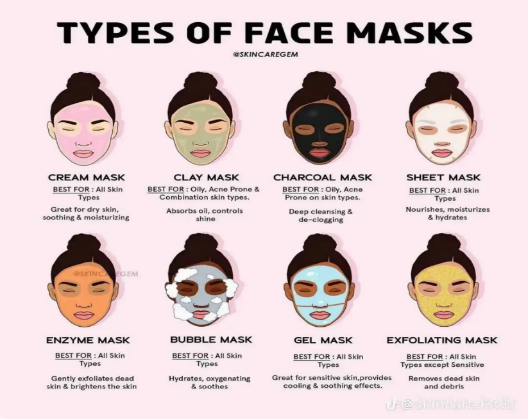
Figure 3: Types of Face Mask
1.5 What is the right way to use a peel-off mask [11]
- With the right cleanser for your face, gently cleanse your face. ...
- Gently apply the Golden Glow Peel Off Mask and ensure it is properly placed on the face.
- Leave the peel-off mask for fifteen minutes.
- Peel the mask off and splash your face with some cold water.
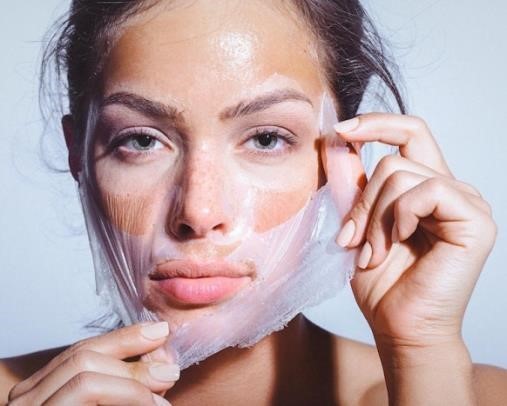
Figure 4: Peel off face mask
1.7 Advantage of peel off gel mask [13,14]
- It repairs and rejuvenate skin tone, gives a health hydrated glow to the skin.
- It also helps to tone the skin and treat the wrinkles.
- Significantly improved skin profile is rapidly achieved.
- Peel of mask can be used for cleaning and moisturizing the skin.
- Suitable for all types of skin.
- It beneficial to remove blackheads, dead skin.
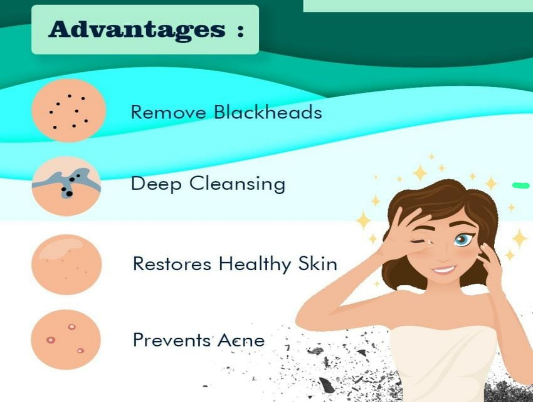
Figure 5:Advantages of peel off mask
1.8 Anti- Aging[15]
Aging is a normal process, but there are things you can do to slow it down and keep your skin healthy. Here are some tips for anti-aging:
- Protect your skin from the sun: Use sunscreen with an SPF of at least 30 every day, even when you're in the shade. You can also wear a hat and clothing to protect your skin.
- Eat a healthy diet: Eat plenty of fruits and vegetables, and avoid too much sugar and refined carbohydrates.
- Exercise regularly: Physical activity improves circulation and boosts your immune system.
- Manage stress: Stress can affect your skin and immune system, so try to find healthy ways to manage it.
- Get enough sleep: Getting less than seven hours of sleep can age your cells more quickly.
- Take care of your skin: Wash your face twice a day with a gentle cleanser, and avoid harsh products. Moisturizing regularly can help prevent wrinkles.
- Quit smoking: Smoking can cause skin wrinkles and hair loss.
- Drink less alcohol: Alcohol can dehydrate your skin, which can cause damage over time.
Use eye cream: Eye creams can help minimize puffiness and darkening under your eyes
1.9 Herbal Ingredient Used in Peel Off Mask
A. Curry Leaves:- Curry leaves (Murraya koenigii) are a well-known leaf spice that are used in very small amounts for their distinctive aroma because they contain volatile oil and can enhance flavour, Digestion. In Asian cuisines, these leaves are frequently used to flavour meals. The leaves' flavour and other characteristics are retained even after drying; they have a little aromatic, bitter, and acidic taste. In several ancient cultures, including Indian Ayurvedic and Unani prescriptions, curry leaf is also employed[20].
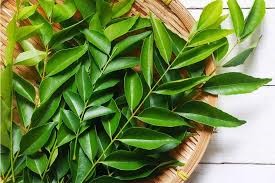
Figure 6: Murraya koenigii leaves
B. Leaves:- Fresh Murraya koenigii leaves include between 61.77 and 66.2% moisture, 2.1-12.5% protein, 14.6-18.97% total sugar, 9.7-13.06% total ash, 1.35 and 1.82?id insoluble ash, 1.35 and 1.82% Alcohol soluble extractive, and 27.33 and 33.45% water extractive value. It explains the Nutritional value. Alkaloids, flavonoids, and sterols have been extracted using solvents such as Ethyl acetate, ethanol, petroleum ether, water, and chloroform during the manufacture of the Extract[21].
C. Nutmeg:- Most taxonomists are familiar with the evergreen nutmeg tree (Myristica fragrans), which is a member of the Myristicaceae family of flowering plants that are native to Asia, Africa, the Pacific islands, and America [21].
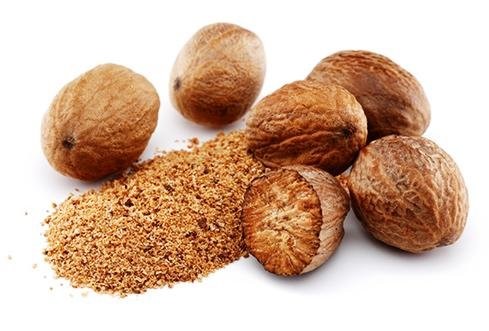
Figure 6: Myristica fragrans (Nutmeg)
D. Fenugreek:- Fenugreek is one of the oldest medicinal plants with exceptional medicinal and nutritional profile. Fenugreek seeds contain a substantial amount of fiber, phospholipids, glycolipids, oleic acid, linolenic acid, linoleic acid, choline, vitamins A, B1, B2, C, nicotinic acid, niacin, and many other functional elements. It may grow well under diverse and a wide range of conditions; it is moderately tolerant to drought and salinity, and can even be grown on marginal lands in profitable way. Owing to these characteristics and heavy metal remediation potential, fenugreek may well fit several cropping systems. In addition to its medicinal uses, it may serve as an excellent off-season fodder and animal food supplement. However, efforts should be initiated to develop strategies for improving its biomass production; genetic diversity among different accessions may be mapped, breeding and crop improvement programs may be initiated to improve the biomass and nutritional and functional elements. This review highlights the morphology, adaptability, nutritional constituents and associated functionality and medicinal significance of fenugreek; its ethno-historical uses, pharmacological assumptions[22].
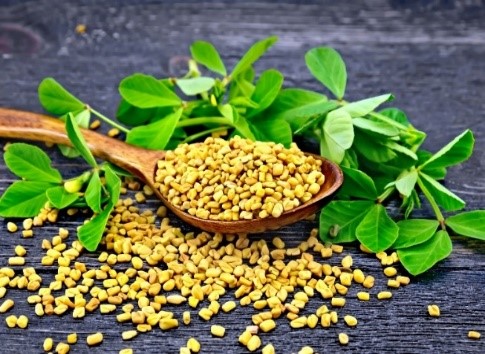
Figure 7:- Fenugreek seed
2.Evaluation parameters
1. Organoleptic Properties: Following characteristics are evaluated during the evaluation of Peel Off Mask.
- Colour
- Odour
- Smell
- Consistency
2. pH: The pH value of herbal peel off mask determines by using pH paper and pH value of peel off mask was about 6.5[16].
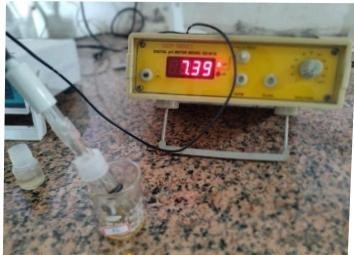
Figure 8:- ph meter
3. Irritancy Test: The irritation test done by applying a formulation on hand’s back skin and leave it for 15 minutes to check irritation reaction such as swelling, itching and redness effect on the skin[17].
4. Spread ability Test: Placed l gm formulation on a butter paper and on the formulation put watch glass. After that 5gm weight place on watch glass for 2 minute to compress the sample to uniform thickness and its diameter will be measure[16].
Formula -
S = m x l/t
Where, S - Spread ability m - Weight tied to upper slide l - Length moved on glass slide t - Time taken[18].
5. Peel off Test: The formulation film of 4x4mm will be spread on backside of the hands skin. Leave it for 15-20 minutes to dry properly. After 15-20 minutes, peel off the dry film from the skin surface. Easy removal of peel without any complications will be observed[16].
6. Folding Endurance: The formulation film will be applied onto the skin. After drying, a portion of film (3x3cm) will be cut and folded it at the same place until it gets broken. Folding endurance can be defined as the value of number of times the film can be folded without breaking.[16]
7. After Feeling: After the utilization of fixed measure of peel off face mask emollience, thickness, and measure of build-up left will be checked.[16]
8. Homogeneity test: 0.1g of mask preparation is weigh then smeared on transparent glass plate and visually and see if there are any parts that are not mixed properly[19]
Table1: Components of peel off mask can include
|
Composition
|
Role
|
|
Fenugreek powder
|
Antiaging
|
|
Polyvinyl alcohol (PVA)
|
Film former
|
|
Propylene glycol
|
Plasticizer
|
|
Ethylene glycol
|
Plasticizer
|
|
Glycerol
|
Humectant
|
|
Sodium lauryl sulphate
|
Surfactant
|
|
Methyl paraben
|
Preservatives
|
|
Propyl paraben
|
Preservatives
|
|
Disodium edta
|
Antioxidants
|
|
Lavender oil
|
Rejuvenate the skin
|
|
Triethanolamine
|
pH adjuster
|
|
Citric acid
|
Antioxidants
|
|
Water
|
Base
|
1.12 Skincare
The concept of skin care is not well defined. It is a kind of umbrella term covering cleansing, perfuming, changing appearance, changing body odor, protecting and keeping the skin in “good condition”. In the last decades our perception of skin care has broadened and soothing of skin symptoms/conditions, and improvement and restoration of the skin’s barrier function and integrity have been added. Today, modern skin care includes cleansing, soothing, restoring, reinforcing and protecting. With increasing age the emphasis on skin care is changing[23,24]. The importance of soothing, restoring, reinforcing increases and cleansing should be executed with particular care. The character of skin care shifts from more cosmetic objectives e smooth, healthy looking skin e to more therapeutic and preventive objectives e soothing, restoring, reinforcing and protecting stressed skin. Even though skin care and skin protection plays an important role throughout lifetime the noxes and the skin areas in primary need of care and protection also change. In younger years environmental noxes (e.g., UV radiation) are of primary importance whereas in advanced years age-related noxes (e.g., prolonged exposure to various sources of moisture, including urine or feces, perspiration, wound exudate, and their contents) become more important. Subsequently the skin areas in need of care and protection also change e initially skin areas (e.g., face, arms, legs) exposed to the the external environment and later enclosed skin areas (e.g., skin folds, perianal, perigenital skin, groin, feet) become the vulnerable zones (hot spots) [25,26].
- AIM And Objective
2.1 Aim: The aim of the present study of Herbal Peel off mask-an approach to anti-aging and skincare.
2.3 Objective:
- To Investigate the efficacy of peel-off masks in improving skin texture and appearance.
- To evaluate the safety and tolerability of peel-off masks on various skin types.
- To compare the effectiveness of different types of peel-off masks (e.g., charcoal, hydrating, exfoliating).
- To evaluate the efficacy of peel- To off masks in reducing acne lesions and inflammation
- To study Preparation of herbal peel of face mask.
- To examine process of Identification, collection of herbal plants.
- CONCLUSION
Peel-off masks can be an effective way to achieve healthy skin by exfoliating, cleansing, and reducing pores. However, it's important to choose the right mask for your skin type and apply it correctly. This study investigated the efficacy and safety of peel-off masks for various skin concerns, including anti-aging, acne, and hydration. The results demonstrate that peel-off masks can:
- Significantly improve skin elasticity and firmness.
- Reduce fine lines and wrinkles.
- Enhance skin hydration and moisture retention.
- Exhibit anti-inflammatory and antioxidant properties.
- Provide a notable reduction in acne lesions.
REFERENCES
- S. Wahdaningsih , S. Rizkifani , E. Utari ; Anti-Aging Peel-Off mark of Dragon fruit peel extract ;Journal Farmasi sains Dan Praktis;2023;270-276;9No.3.
- Himaja N, Ashok Kumar A, Bharat Kumar B; “Preparation and Evaluation of Poly Herbal Fruit Face Mask”; Journal of Research in Pharmaceutical Science; 2015; Volume 2; Issue 11; Pg. no. 07-149;84issue (4).
- S. Mahajan , H. Patil , K.Solanki , T. Tare , S. Wagh , P. Sonare , V. Bairagi ,Research article on Formulation and Evaluation of Multi-Herb Peel Off Mask; International Journal Pharmaceutical sciences Review and research ; 2024;143
- S. Somwanshi, K. Kudale, R. Dolas, K. Kotade; “Formulation and Evaluation of Cosmetic Herbal Face Pack for Glowing Skin”; International Journal Research Ayurveda Pharm;2017;199-203;8issue3.
- R. Bijauliya, S.Alok, M. Kumar, D. Chanchal ,S.Yadav; “A Comprehensive Review on Herbal Cosmetics”; International Journal of Pharmaceutical Sciences and Research; 2017;4930-4949;8(12).
- P. Ghadge, S. Mahamuni, D. Kachare; “Formulation and Evaluation of Herbal Scrub Using Tamarind Peel”; International Journal of Research; 2020; 1-10;10.
- S. Dhanashri, A. Mane, V. Kumbhar, K. Shaha; “Formulation & Evaluation of Herbal Anti-Acne Face Wash”; World Journal of Pharmacy and Pharmaceutical Sciences; 2016;2001-2007;7Issue6.
- h
- G. Maghraby , B.Barry , A. Williams , Liposome and skin : From drug delivery to model membrane ,European journal pharmaceutical science;2008,203-222;34issue4-5
- C. Noble, The skin microflora and microbial skin disease, university of Cambrdige, Cambridge.
- R.Shamly H.Nasrin ,Design and Formulation and Optimization of peel off Face Mask Gel for the treatment of Rosacea, journal of pharmaceutical research science and technology (2022) vol 6
- Belinda Carli, Formulating Facial Masks, May 24, 2018
- Research Article on Formulation and Evaluation of Activated Charcoal Peel Off Mask by Sweta Kulkarni in International journal of pharmacy Research & Technology July-December 2019 ,Vol 9, Issue 2.
- S. Lokhande ,Article on Formulation and Evaluation of Polyherbal peel off mask ;Asian journal of Pharmaceutical Research and Development; 2024;23-28;12(3).
- h
- P. Shukla, S. Tiwari, S. Singh, Shadab, A. Yadav; formulation and evaluation of activated charcoal peel off face mask, Journal of Pharmaceutical sciences and Research;2023;1020-1024;15(2).
- M. Alzohairy; Therapeutics Role of Azadirachta indica (Neem) and Their Active Constituents in Diseases Prevention and Treatment; National library of Medicine;20167382506
- S.Ahmad,M.Ahmad,B.Swami,S.Ikram; A review on plant extract mediated synthesis of silver nanoparticles for antimicrobial applications: A green expertise; Journal of Advanced Research;2016; 17-28;7.
- T.Jani, A.Hakim, Y.Juliantoni; Formulation and Evaluation of Anti-oxidant peel of mask containing Red Dragon Fruit Rind Extract (Hylocereus polyrhizus Haw.); Journal Biology Tropis;2020;438;20(3).
- A.Joshi, V.Shahane, V.Gore, and R.Bharadwaj; Herbal Ingredient used in peel off mask Hindustan antibiotics Bulletin, 2009; 47-48;7.
- S. Gupta, M. George, M. Singhal, G.Sharma, V. Garg; Leaves extract of Murraya koenigii Linn for anti- Inflammatory and analgesic activity in animal models. Journal of Advance Pharmaceutical Technology and Research; 2010;68-77;1(1).
- A. Ahmad ,S.Alghamdi K. Mahmood, M. Afzal; Review on Fenugreek a multipurpose crop: Potentialities and improvements ; Saudi Journal of Biological Sciences; 2016;300-310;23issue2
- J. Kottner , A. Lichterfeld , U. Blume-Peytavi , A. Kuhlmey . Skin health promotion in the elderly. National Library of medicine; 2015;489(3).
- B. Dreno , E. Araviiskaia , E. Berardesca , T. Bieber , J. Hawk , M. Sanchez-Viera , P. Wolkenstein; The science of dermocosmetics and its role in dermatology; Journal of the European Academy of Dermatology and Venereology ; 2014;1409-1417;28Issue11.
- R.McLeod, P.Elias, L.Eichenfield, J.Fowler , P.Horowitz ;A lifetime of well skin care: practical recommendations for clinicians and patients;National Library Of Medicine;2013;32.
- A.Lichterfeld , A.Hauss, C.Surber , T.Peters , U.Blume-Peytavi,J.Kottner; Evidence-based skin care: a systematic literature review and the development of a basic skin care algorithm; J Wound Ostomy Cont Nurs; 2015;501-524;42(5)


 Nikhil Samarth*
Nikhil Samarth*
 Nandini Band
Nandini Band
 Mohit Sonare
Mohit Sonare
 Mahesh Gadge
Mahesh Gadge









 10.5281/zenodo.14642907
10.5281/zenodo.14642907